Plantar Fasciitis
Updated:
(Also known as Heel Pain, Heel Spurs, Painful Heel Syndrome)
What is plantar fasciitis?
Plantar fasciitis is a condition characterised by damage and inflammation to the plantar fascia (i.e. the connective tissue on the sole of the foot forming the inner arch – figure 1). This usually occurs at the attachment of the plantar fascia to the heel bone. Plantar fasciitis is the most common cause of heel pain seen in clinical practice.
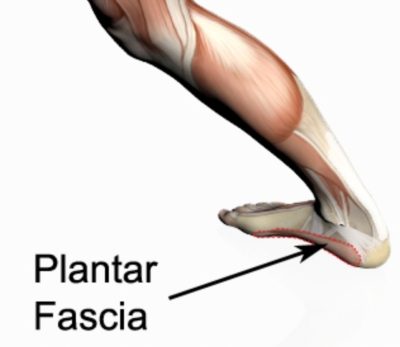
During walking or running, tension is placed through the plantar fascia. When this tension is excessive (often due to poor foot biomechanics such as flat feet – figure 2) or if it is too repetitive or forceful, damage to the plantar fascia can occur. Plantar fasciitis is a condition where there is damage to the plantar fascia with subsequent inflammation and degeneration. This may occur traumatically due to a high force going through the plantar fascia beyond what it can withstand or, more commonly, due to gradual wear and tear associated with overuse. Occasionally, a heel spur may develop in association with plantar fasciitis.
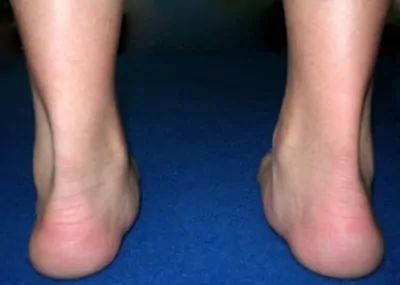
Causes of plantar fasciitis
Plantar fasciitis most commonly occurs due to repetitive or prolonged activities placing strain on the plantar fascia. It is often seen in runners, or dancers and gymnasts who perform regular activities involving end of range foot and ankle movements. It may also occur in patients who walk excessively, especially up hills or on uneven surfaces. Older patients who spend a lot of time on their feet may also develop the condition. Plantar fasciitis frequently occurs in association with calf muscle tightness, inappropriate footwear, or biomechanical abnormalities, such as excessive pronation (flat feet – figure 2) or supination (high arches). Occasionally the condition may occur suddenly due to a high force going through the plantar fascia beyond what it can withstand. This may be due to activities such as a sudden acceleration or a forceful jump.
Signs and symptoms of plantar fasciitis
Patients with plantar fasciitis typically experience pain underneath the heel and along the inner sole of the foot. In less severe cases, patients may only experience an ache or stiffness in the plantar fascia or heel that increases with rest (typically at night or first thing in the morning) following activities which place stress on the plantar fascia. These activities typically include standing, walking or running excessively (especially up hills, on uneven surfaces or in poor footwear such as thongs), jumping, hopping and general weight bearing activity. The pain associated with this condition may also warm up with activity in the initial stages of injury. As the condition progresses, patients may experience symptoms that increase during sport or activity, affecting performance. In severe cases, patients may walk with a limp or be unable to weight bear on the affected leg.
Patients with this condition may also experience swelling, tenderness on firmly touching the plantar fascia (often on a specific spot on the inner aspect of the heel) and sometimes pain on performing a plantar fascia stretch.
Diagnosis of plantar fasciitis
A thorough subjective and objective examination from a physiotherapist is usually sufficient to diagnose plantar fasciitis. Occasionally, further investigations such as an X-ray, ultrasound or MRI may be required to assist with diagnosis and assess the severity of the condition.
Prognosis of plantar fasciitis
Most patients with this condition heal well with appropriate physiotherapy. Minor cases of plantar fasciitis that have not been present for long can usually recover within a few weeks. In patients who have had their condition for a long period of time, recovery can be a lengthy process and may take a number of months. Early physiotherapy treatment is therefore vital to hasten recovery.
Treatment for plantar fasciitis

Members Only ContentBecome a PhysioAdvisor Member to gain full access to this exclusive content. For more details see Become a Member. Already a member? Login Now
Contributing factors to the development of plantar fasciitis
There are several factors which can predispose patients to developing plantar fasciitis. These need to be assessed and corrected with direction from a physiotherapist. Some of these factors include:
- poor foot posture (especially flat feet – figure 2)
- foot or ankle stiffness
- muscle tightness (particularly in the calf)
- inappropriate or excessive training
- being overweight
- poor biomechanics
- inappropriate footwear
- inadequate warm up
- muscle weakness
- leg length differences
- poor proprioception or balance
- poor core stability
Physiotherapy for plantar fasciitis
Physiotherapy treatment for patients with this condition is vital to hasten the healing process, ensure an optimal outcome and reduce the likelihood of recurrence. Treatment may comprise:
- soft tissue massage
- joint mobilization
- electrotherapy (e.g. ultrasound)
- arch support taping
- ice or heat treatment
- dry needling
- the use of heel padding, a heel wedge or a heel cup
- the use of crutches
- the use of a night splint (in some cases)
- anti-inflammatory advice
- exercises to improve balance, strength and flexibility (particularly of the calf muscles)
- education
- activity modification advice
- biomechanical correction (e.g. the use of orthotics)
- footwear assessment
- devising an appropriate return to activity plan
- a gradual return to running program
Other intervention for plantar fasciitis
Despite appropriate physiotherapy management, some patients with this condition do not improve. When this occurs the treating physiotherapist or doctor will advise on the best course of management. This may include further investigations (such as X-rays, Ultrasound, MRI scan), pharmaceutical intervention, corticosteroid injection, autologous blood injection or referral to appropriate medical authorities who can advise on any intervention that may be appropriate to improve the condition. A review with a podiatrist may also be required for prescription of orthotics to improve foot posture and function. In very rare chronic cases surgical intervention may be considered.
Exercises for plantar fasciitis
The following exercises are commonly prescribed to patients with this condition. You should discuss the suitability of these exercises with your physiotherapist prior to beginning them. Generally, they should be performed 2 – 3 times daily and only provided they do not cause or increase symptoms.
Your physiotherapist can advise when it is appropriate to begin the initial exercises and eventually progress to the intermediate and advanced exercises. As a general rule, addition of exercises or progression to more advanced exercises should take place provided there is no increase in symptoms.
Initial Exercises
Calf Stretch with Towel
Begin this stretch in long sitting with your leg to be stretched in front of you. Your knee and back should be straight and a towel or rigid band placed around your foot as demonstrated (figure 3). Using your foot, ankle and the towel, bring your toes towards your head until you feel a stretch in the back of your calf, Achilles tendon, plantar fascia or leg. Hold for 5 seconds and repeat 10 times at a mild to moderate stretch provided the exercise is pain free.

Resistance Band Calf Strengthening
Begin this exercise with a resistance band around your foot as demonstrated and your foot and ankle held up towards your head (figure 4). Slowly move your foot and ankle down against the resistance band as far as possible and comfortable without pain, tightening your calf muscle. Very slowly return back to the starting position. Repeat 10 – 20 times provided the exercise is pain free.
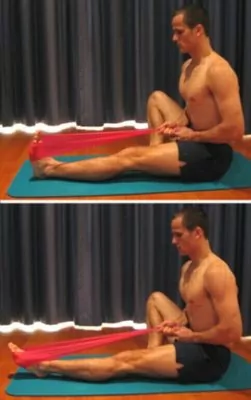
Intermediate Exercises

Members Only ContentBecome a PhysioAdvisor Member to gain full access to this exclusive content. For more details see Become a Member. Already a member? Login Now
Advanced Exercises

Members Only ContentBecome a PhysioAdvisor Member to gain full access to this exclusive content. For more details see Become a Member. Already a member? Login Now
Rehabilitation Protocol for Plantar Fasciitis

Members Only ContentBecome a PhysioAdvisor Member to gain full access to this exclusive content. For more details see Become a Member. Already a member? Login Now
Find a Physio
Find a physiotherapist in your local area who can treat plantar fasciitis.
More Information
- View more Ankle Flexibility Exercises.
- View Ankle Strengthening Exercises.
- View more Calf Flexibility Exercises.
- View Calf Strengthening Exercises.
- View Balance Exercises.
- Read about Correct Footwear for running.
- Read about How to use Crutches correctly.
- View Do I Need Orthotics?
- View a Return to Running Program.
- Read about when to use Ice or Heat.
- Read about initial injury management and the R.I.C.E. Regime.
- Read about Understanding Pain
- Read about Foot Taping Techniques.
- View our Foot Diagnosis Guide.
Physiotherapy products for plantar fasciitis
Some commonly recommended products by physiotherapists for patients with this condition include:
-
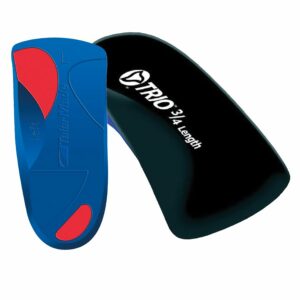 Talar Made TRIO Orthotics (3/4 length)
Talar Made TRIO Orthotics (3/4 length) -
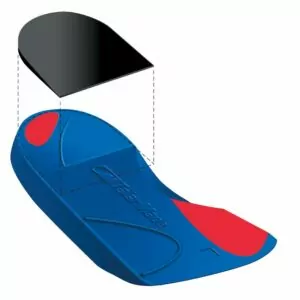 Heel Lifts (Elevators – Talar Made) (Pack of 5 Pairs)
Heel Lifts (Elevators – Talar Made) (Pack of 5 Pairs) -
 Forearm Crutches Adjustable – Standard Grip
Forearm Crutches Adjustable – Standard Grip -
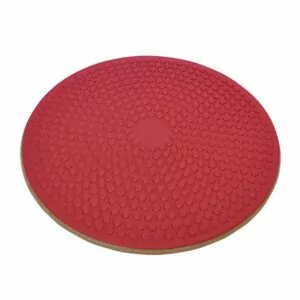 AllCare Wobble Board (Red – ACWOBRD)
AllCare Wobble Board (Red – ACWOBRD) -
 AllCare Band
AllCare Band -
 Premium Strapping Tape 38mm (Victor)
Premium Strapping Tape 38mm (Victor) -
 AllCare Tubing
AllCare Tubing -
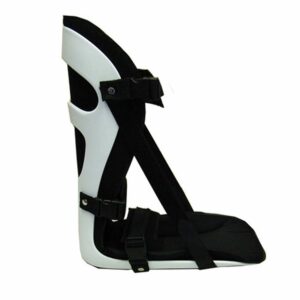 AllCare Ortho Night Splint
AllCare Ortho Night Splint -
 Fixomull Stretch 5cm x 10m
Fixomull Stretch 5cm x 10m -
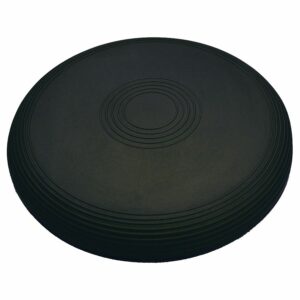 Lournet Stability Dura Disc
Lournet Stability Dura Disc -
 AllCare Ortho Standard Walker (Cam Boot)
AllCare Ortho Standard Walker (Cam Boot)
To purchase physiotherapy products for plantar fasciitis click on one of the above links or visit the PhysioAdvisor Shop.
Become a PhysioAdvisor Member
-
 Individual Membership (12 Months)$59.95 for 1 year
Individual Membership (12 Months)$59.95 for 1 year -
 Individual Membership (3 Months)$39.95 for 3 months
Individual Membership (3 Months)$39.95 for 3 months -
 Individual Membership (Yearly)$49.95 / year
Individual Membership (Yearly)$49.95 / year -
 Individual Membership (Monthly)$15.95 / month
Individual Membership (Monthly)$15.95 / month

Link to this Page
If you would like to link to this article on your website, simply copy the code below and add it to your page:
<a href="https://physioadvisor.com.au/injuries/foot/plantar-fasciitis”>Plantar Fasciitis – PhysioAdvisor.com</a><br/>PhysioAdvisor offers detailed physiotherapy information on plantar fasciitis including causes, symptoms, diagnosis, treatment, exercises, rehabilitation protocol, physiotherapy products and more...
Return to the top of Plantar Fasciitis.
